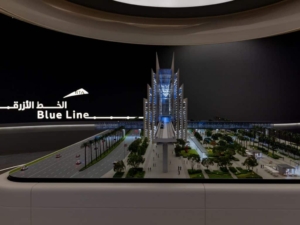
Dubai’s Metro network is expanding with the new Blue Line – 14 stations officially confirmed across key areas (Emaar South, Dubai Hills, Creek Harbour, Mirdif, Academic City, etc.). Learn which communities get stations, how it fits Dubai’s 2040 plan, and what this means for real estate values and investments.
Dubai’s transport network is entering a new era of expansion. In a breaking announcement, the Roads and Transport Authority (RTA) has confirmed the route and station locations for the upcoming Dubai Metro Blue Line – a 30 km addition that will bring 14 new stations by 2029. This major metro extension will link several fast-growing communities – from the waterfront towers of Dubai Creek Harbour to the suburban enclaves of Mirdif and Academic City – marking a transformative leap in urban connectivity. Crucially, many of these areas have never had Metro access before, so the confirmed stations are a game-changer for residents and investors alike.
Why does this matter? Beyond shorter commutes and new transit options, the Blue Line is set to boost property values and spur development in each connected neighborhood, aligning with Dubai’s drive toward a “20-minute city” under the 2040 Urban Master Plan.
To put it simply: Dubai is about to get better connected than ever. Below, we detail all the major areas officially getting Blue Line stations, clarify which stops are confirmed or still in planning, and explore how this expansion fits into the city’s growth vision. We also highlight the real estate impact – from rising home values to new investment opportunities – and why now is the time to watch these metro-linked communities.

Confirmed Metro Stations on the Blue Line
The Dubai Metro Blue Line will span two branches that integrate with the existing Red and Green Lines, bringing direct Metro service to nine key districts. The following areas are officially confirmed to receive new stations as part of the Blue Line rollout:
- Dubai Creek Harbour (Emaar Properties Station) – A flagship stop on the Blue Line, located in the Creek Harbour mega-project. The Emaar Properties Station will be an architectural icon and the world’s tallest metro station at 74 m high. It anchors this waterfront community, connecting it via a 1.3 km bridge to the existing Creek terminus of the Green Line. This stunning station – designed by the architects of Burj Khalifa – is projected to handle 70,000+ daily riders by 2040, vastly improving access for the 40,000 residents of Dubai Creek Harbour. It’s a showpiece interchange that puts the new Creek developments on the Metro map.
- Dubai Festival City – A major retail and business district on the Creek, finally getting a Metro stop. The Blue Line will include a station serving Dubai Festival City, ending the long wait of residents and shoppers for direct rail connectivity. This station links into the Creek Harbour route, giving Festival City a quick link to Downtown and beyond.
- Ras Al Khor Industrial Area – An industrial and future creative zone near the wildlife sanctuary, set to be connected by the Blue Line. A station here will facilitate commutes for workers and visitors, and dovetails with plans to redevelop parts of Ras Al Khor into a mixed-use hub. It’s part of bringing older industrial areas into the urban fold with modern transit.
- International City – Stations 1, 2, 3 – The sprawling International City community will be served by multiple stations. One of these will be an underground interchange station of 44,000 m², the largest in the network, capable of 350,000 daily passengers. The Blue Line effectively tunnels beneath International City phases 1, 2 and 3, finally linking this dense residential zone (and its Dragon Mart retail hub) to the Metro. International City Station 1 will also connect the two Blue Line branches (from Creek Harbour and from Rashidiya) and interchange with the Red Line in the future. This turns International City into a pivotal transit hub and should greatly cut travel times for its population.
- Mirdif – The popular suburban district of Mirdif will get a Metro station for the first time, via a Blue Line branch that starts at the Red Line’s Centrepoint (Rashidiya) Station. The Mirdif station is confirmed and will be underground, likely in the Mirdif City Centre mall area. This provides a huge connectivity boost for Mirdif’s residents, who currently rely on cars or buses – soon they can hop on a train to reach Downtown or the airport in minutes.
- Al Warqa – Adjacent to Mirdif, the Al Warqa’a community is also getting its first Metro station on the Blue Line. Al Warqa is a growing residential area that’s been off the transit grid; a station here (also on the Rashidiya–Mirdif branch) will integrate it with the city. Like Mirdif, the Al Warqa stop is planned as an underground station for seamless connectivity.
- Dubai Silicon Oasis (DSO) – This high-tech business and residential district in eastern Dubai is confirmed for a Blue Line station. Silicon Oasis, home to tech companies and a large university campus, has long been underserved by transit. The new station will slash commute times – e.g. a tech professional in DSO will be able to reach Downtown or DXB Airport without driving. This stop positions DSO as a key node in the network and is expected to make living and working there far more convenient.
- Dubai Academic City – At the terminus of the Blue Line’s main route, Dubai International Academic City will gain a Metro station, linking dozens of universities and student housing areas to the city. By 2029, an estimated 50,000+ students in Academic City can ride the Metro to and from campus, drastically improving accessibility to this education hub. It’s a strategic move to support Dubai’s knowledge economy – and a relief for students who today face long shuttle bus rides.
- Al Jaddaf (Creek Interchange) – While Al Jaddaf is already on the Green Line (Creek Station), it will become a critical interchange where the Blue Line begins/ends on the Creek side. The project includes integrating the new Emaar Station with the existing Creek Station via a pedestrian link. This means riders can transfer between Green and Blue lines conveniently at Al Jaddaf, connecting old Dubai to the new eastern route.
- Al Rashidiya (Centrepoint Interchange) – Similarly, the Blue Line’s secondary branch will start at Centrepoint (Rashidiya) on the Red Line. Centrepoint is the Red Line’s end near Dubai International Airport (DXB). A new interchange there will route Blue Line trains toward Mirdif/Warqa and then merge into the main line at International City. In effect, Rashidiya becomes a gateway station funneling airport-area travelers onto the Blue Line and vice versa.
As we can see, the confirmed Blue Line stations span a wide geography – connecting older districts and emerging suburbs in one sweep. From Creek Harbour and Festival City in the north, through the Ras Al Khor and International City corridor, and out to Silicon Oasis and Academic City in the east, plus a branch into Mirdif/Al Warqa, the Blue Line casts a wide net.
Nine strategic areas are directly served, covering a population of over one million people by 2040. Crucially, many of these neighborhoods (Mirdif, Warqa, DSO, Academic City, etc.) were car-dependent suburbs until now. The Metro’s arrival will weave them into Dubai’s transit fabric, cut commute times dramatically (some trips that took 40+ minutes by car may drop to 10–20 minutes by train), and elevate the convenience of living there.

Future Expansion Plans: Emaar South, Dubai Hills and Other Upcoming Stations
What about other booming areas like Emaar South and Dubai Hills? While these are not on the Blue Line’s 2029 route, they are very much part of Dubai’s broader metro expansion vision. The city’s master plan involves additional new lines (Purple, Gold, etc.) by 2030 to ensure all major growth zones get connected. Here’s how Emaar South and Dubai Hills fit into the picture:
- Emaar South (Dubai South) – The Dubai South district near Al Maktoum International Airport (DWC) – which includes the Emaar South residential community – is slated for a future Metro link. In fact, recent RTA announcements effectively confirm a station near Emaar South in the next phase of expansion. Plans call for extending the Route 2020 Red Line further south from the Expo 2020 terminus to reach DWC airport, establishing a station serving Emaar South on the way. This means the new Expo City and Emaar South developments will eventually have a direct Metro connection, aligning with Dubai’s strategy to integrate the massive Dubai South area. While timelines are still being finalized, the inclusion of Emaar South in metro plans is great news for investors and residents there – it will no longer be “too far out,” but instead just a train ride from the rest of Dubai. The confirmed intent to link Emaar South via Metro has already heightened interest in this area as the next big growth corridor.
- Dubai Hills Estate – One of Dubai’s premier master communities, Dubai Hills (located along Al Khail Road in Mohammad Bin Rashid City) is poised to get its own Metro station as part of the proposed Purple Line. Earlier plans and developer documents show a Dubai Hills Mall Station on the Metro, connecting the community directly to both Dubai International Airport and Al Maktoum Airport via the Purple Line. In fact, the Purple Line is envisioned to run along Al Khail Road, underground through Dubai Hills, linking into the Expo/DWC route. While the RTA has not given an official opening date for the Dubai Hills station yet, the project has been touted by Emaar and planners – essentially confirming Dubai Hills will be served in the Metro’s next expansion wave. For the large population in and around Dubai Hills Estate (and its busy mall), this will be a huge connectivity boost. Instead of relying on feeder buses to the Metro, residents will eventually have a station at their doorstep, slashing travel times to Downtown and the airports. It’s worth noting that the same Purple Line will also tie into other new communities along Al Khail Road, further ensuring Dubai Hills is plugged into a city-wide network.
- Other Lines and Areas – The Blue Line and future Purple Line are part of a wider metro expansion that includes a proposed Gold Line and Pink Line as well. The Gold Line, for example, will run from old Dubai (Al Ghubaiba) out to Meydan and Dubailand (areas like Global Village), giving newer suburbs in the west a metro link. The Pink Line may connect places like Al Sufouh/Jumeirah to Dubailand in an east-west axis. All these plans are geared towards coverage of emerging developments – from Damac Lagoons and Motor City to new coastal projects – ensuring that virtually every major community in the 2030s will be within reach of a Metro station. While details are still being confirmed by RTA, the overarching vision is clear: by 2040, Dubai will have about 140 Metro stations (up from around 60 today) covering all corners of the city. This integrated network will support Dubai’s fast-growing population and make good on the promise of the 2040 Urban Master Plan: a city where residents can access work, home, and leisure within 20 minutes via efficient transport.
In summary, Emaar South and Dubai Hills are on the radar for upcoming Metro service, even if they’re not on the immediate Blue Line. These communities align perfectly with the direction of Dubai’s growth – near a new airport and major residential hubs – and the government is actively planning to serve them. It’s a question of when (likely by the early 2030s) rather than if. For real estate stakeholders, keeping an eye on these future stations is just as important as the confirmed Blue Line stops.

A scale model of the upcoming Emaar Properties Station in Dubai Creek Harbour – set to be the world’s tallest metro stop at 74 m – was unveiled during the Blue Line’s launch. This iconic “gateway” station will feature striking architecture and connect via a creek-spanning viaduct to the Green Line, symbolizing Dubai’s blend of visionary design and transit connectivity.
Driving Dubai’s 2040 Vision: Metro Expansion and Population Growth
The Metro Blue Line isn’t happening in isolation – it’s a cornerstone of Dubai’s broader strategy to accommodate a rapidly growing city. Dubai’s population is projected to swell well beyond 5 million by 2040, and the government’s response is the Dubai 2040 Urban Master Plan, which emphasizes sustainable growth, smart mobility, and decentralization of city centers. The confirmed Blue Line stations are deliberately aligned with this vision:
- 20-Minute City: The goal is for residents to reach daily needs within 20 minutes by walking or public transport. By running the Metro through new areas like Academic City, Silicon Oasis, Mirdif, etc., the Blue Line brings these districts into closer “temporal” proximity with the rest of Dubai. A student in Academic City will be able to get to, say, Dubai Mall or Dubai Marina much faster than today – knitting the city together and reducing reliance on cars. Every new station is a step toward the 20-minute city ideal.
- Transit-Oriented Development: Placing stations in high-density growth areas supports Dubai’s plan to focus development around transit hubs. The Executive Council explicitly aims to boost the population and amenities around Metro stations as part of urban planning. We can expect areas like International City and Silicon Oasis to see new retail centers, offices, and housing within walking distance of the stations. In fact, the RTA is designing some new stations (like the large International City interchange) to anchor future mixed-use complexes, ensuring that metro stops become community focal points rather than just train platforms.
- Better Quality of Life: By cutting commute times and offering more public transport coverage, the Metro expansion directly tackles traffic congestion and long drive times – two pain points of fast-growing cities. Residents of outer areas will spend less time in transit and more time at home or work. As one Dubai Creek Harbour resident noted about the Blue Line, “The connectivity improves quality of living in our community and increases the value of our properties. It’s a true blessing for everyone around here.”. This sentiment will likely be shared in Mirdif, Warqa, DSO, and others once the stations open. Moreover, a more extensive metro network has environmental and social benefits: it encourages people to shift from private cars to a cleaner, efficient system, aligning with Dubai’s sustainability goals (like lowering carbon emissions per capita).
- Capacity for Growth: The numbers speak volumes – by 2030 the city plans to have 96 Metro stations (up from 64 today), and by 2040 around 140 stations covering 228 km². The Blue Line’s completion in 2029 will extend the rail network to 131 km and 78 stations in total, immediately boosting capacity. The system is being future-proofed with advanced trains and interchanges to handle hundreds of thousands of additional daily riders. In fact, the Blue Line alone is expected to carry over 200,000 passengers a day by 2030, rising to 320,000 daily by 2040 as new communities fill in. This expansion is key to ensuring the city’s infrastructure keeps pace with its ambitious economic and population growth – avoiding strain on roads and ensuring that new districts are not isolated.
Dubai’s leadership has demonstrated its commitment by fast-tracking these projects (the Blue Line’s ground-breaking was in June 2025 by the Ruler of Dubai, with an aim to open by September 2029). The Metro is more than just transport; it’s woven into the city’s development roadmap. As new lines and stations come online, previously peripheral areas become integral parts of the metropolis. This careful alignment of transit with urban planning is a big reason Dubai manages to grow rapidly yet remain livable and investor-friendly.
Real Estate Implications: Value Appreciation, ROI, and Community Development
For real estate investors and homeowners, the confirmation of new Metro stations is very significant. Past trends in Dubai and global cities show that proximity to a metro station boosts property values and rental demand – a phenomenon often termed the “Metro premium.” The Blue Line expansion is set to create exactly that effect across its corridor:
- Dubai’s RTA projects that property prices and rents in neighborhoods along the Blue Line will rise by up to 25% thanks to the improved connectivity. This is a striking figure that underscores how transit access translates to higher real estate value. Underserved districts like Mirdif, Al Warqa, International City, and DSO suddenly become more attractive to buyers and tenants when a Metro is introduced. No longer “far-flung,” they’re a quick train ride away from job centers and attractions, which broadens the buyer pool and increases demand.
- Historical data backs this up. A study by CBRE found that homes within walking distance of Dubai Metro stations appreciated faster than the city average over the last decade. Between 2010 and 2022, property prices near Red Line stations climbed 26.7%, outpacing the roughly 24% citywide average. Even rental rates held strong or rose in those well-connected areas, while rents in more isolated areas declined. This demonstrates a clear ROI advantage: owning near a Metro means your asset tends to gain value more robustly over time. We can expect a similar surge for Blue Line areas – perhaps even larger, given how much these new stations reduce travel hassle in formerly car-only locales.
- Beyond just property values, community development accelerates around new stations. We’re likely to see new retail centers, cafes, offices, and public spaces popping up around Blue Line stops. For instance, land around Academic City or Silicon Oasis stations could be used to build student housing, tech incubators, or shopping complexes to serve the increased foot traffic. The Blue Line is effectively catalyzing new commercial opportunities – investors are already eyeing plots near the announced stations in anticipation of this growth. This transit-oriented development further boosts the livability (and thus desirability) of these areas, creating a virtuous cycle of rising demand.
- Investors looking at rental income can also expect a positive impact. Properties near future Metro stations become hot rental commodities, as many tenants (especially young professionals and students) prioritize transit access. Improved connectivity in places like International City or DSO will likely draw in a new demographic of renters who previously avoided those areas due to the commute. Higher demand can mean stronger rental yields. In other cities, the “rent premium” for being near a metro can be significant, and Dubai should be no different as the network expands.
- Importantly, the Blue Line connects to employment and education hubs (like the industrial zones, universities, and business parks along its route), which can drive job growth in those districts. Businesses may choose to locate where employees have Metro access, boosting office occupancy in, say, Ras Al Khor or DSO. More jobs in turn mean more housing demand nearby – a positive feedback loop for real estate values.
In essence, each confirmed station is not just a transit stop, but a value-creation node. Areas like Mirdif, Silicon Oasis, Ras Al Khor, and International City – once considered peripheral – are expected to see a surge in demand from both tenants and homebuyers as the Metro makes them more accessible and “central” to the urban fabric.
This is a golden opportunity for early investors: getting into these communities before the Metro opens (and the 25% appreciation kicks in) could yield excellent medium to long-term returns. Even for existing homeowners, there’s a strong upside – their property equity is likely to get a healthy boost, and quality of life will improve, making their homes more enjoyable and easier to sell in the future.
From a broader perspective, the Metro expansion spreads the wealth of development. Instead of all growth centering on downtown Dubai, we’ll see multi-nodal growth – with vibrant residential and commercial clusters growing around new station areas. This balanced development is great for the city’s sustainability and ensures that investment potential is not limited to traditional “prime” locations. For example, Dubai South (Emaar South), though on the outskirts, could become “the next Dubai Marina” in terms of investor attention once the promised Metro line and other infrastructure come to fruition. Similarly, Dubai Hills Estate – already upscale – will become even more in-demand once its Metro station is operational, as connectivity will match its luxury lifestyle offerings.
Invest in Metro-Connected Zones – Connect with K&S Properties
Dubai’s Metro expansion is ushering in a new wave of real estate opportunities. Whether it’s along the confirmed Blue Line or in upcoming areas like Emaar South and Dubai Hills, properties in metro-connected zones are positioned for growth in value, convenience, and rental appeal. At K&S Properties, we specialize in identifying these high-ROI opportunities and guiding clients to make the most of them.
The confirmation of new stations is breaking news today, but the real story is how it can benefit you as an investor or homebuyer. Do you want to be stuck in traffic in 2029, or stepping off a train into your thriving new neighborhood? The choice is clear. Areas getting Metro stations – Creek Harbour, Mirdif, Academic City, Dubai South, Dubai Hills and more – are prime spots to consider for your next property move. Many savvy buyers are already positioning themselves in these locations ahead of the Metro’s arrival.
Now is the time to act. If you’re interested in capitalizing on Dubai’s Metro-driven growth, reach out to K&S Properties. Our team has in-depth market knowledge of all these communities and the upcoming projects around them. We can provide insight into which developments will benefit most, expected price trends, and the best timing for entry. From chic apartments near the future Dubai Creek Harbour station to family villas in Mirdif and Al Warqa poised for value jumps, we have options to suit every portfolio.
Don’t miss the train on this investment trend – quite literally. Contact K&S Properties today to explore properties in Dubai’s soon-to-be metro-connected hotspots. We’ll help you secure the right property so that by the time the trains start running, you’ll be riding the wave of growth (instead of watching from the sidelines). With the Metro Blue Line and beyond on track, Dubai’s next real estate boom is already leaving the station – and K&S is here to ensure you’re on board for the journey.
